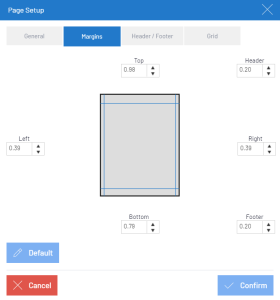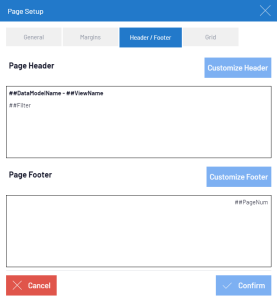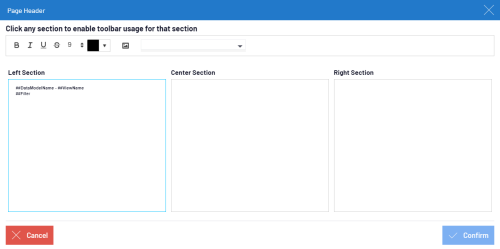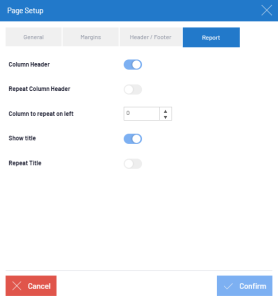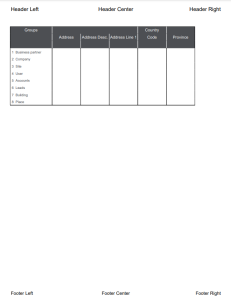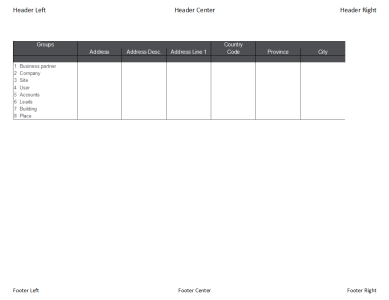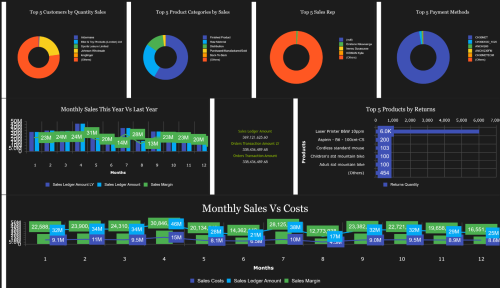Page Setup
Overview
The Page Setup window allows users to customize the layout of their output when exporting a View, Dashboard or Report.
To access the Page Setup window, navigate to the Settings menu (right-hand panel of an open View, Dashboard or Report) and click on Sharing then select Page Setup.
General Tab
Related to Views, Dashboards and Reports
The General tab (shown below) allows the user to define the general configuration options of their export page.
Fields and Values
Orientation - Allows the user to define whether the page will be exported in portrait or landscape orientation
Unit - Allows the user to define the unit of measurement (i.e., centimetres or inches) displayed for paper size and margins.
Paper Size - Allows the user to set a standardized page size (i.e., width and height) for their export; users can also define a width and height manually by selecting the Custom Size option then entering the desired values in the Width and Height fields
Width - Field that represents the width of the export page; its value will update automatically depending on the options selected in the previous three fields, however, users will only be able to change the value manually if the Custom Size option is selected in the Paper Size field
Height - Field that represents the height of the export page; its behaviour is identical to the Width field
Fit to - page(s) wide - Toggle that allows users to define the number of pages within which the content of their export will be fit; Fit to - page(s) wide and Zoom (%) are mutually exclusive options
Zoom (%) - Toggle that allows users to define the zoom percentage to which their export will be displayed; Fit to - page(s) wide and Zoom (%) are mutually exclusive options
Confirm - Allows users to save any adjustments made to the page setup.
The Fit to - page(s) wide and Zoom (%) options only appear in the General tab if they are applicable to the export type.
Margins Tab
Related to Views, Dashboards and Reports
The Margins tab allows users to configure the margins of their export. The tab also provides a simplified margin preview in the centre of the Page Setup window which updates in real-time based on the values entered by the user.
Fields and Values
Default - Button that causes all export margins to revert to their initial, default values
Top, Left, Right and Bottom - Fields that allow the user to define the distance between their export content and the border of the page in all four directions
Header and Footer - Fields that allow the user to define the space between their header or footer and the top or bottom border of the page respectively; the values in these fields should always be less than the margin values to avoid overlapping
Header / Footer Tab
Related to Views, Dashboards and Reports
The Header / Footer tab (shown below) allows users to customize headers and footers and then add them to their export. The tab also provides a preview of how the header or footer will appear in the export.
Fields and Values
Customize Header - Allows users to customize their export's header; clicking the Customize Header button will display the Header Customization pop-up (see below)
Customize Footer - Allows users to customize their export's footer; clicking the Customize Footer button will display the Footer Customization pop-up (see below)
Confirm - Button that finalizes any header or footer customizations entered by the user in the Header / Footer tab
Header / Footer Customization Pop-Up
The Header or Footer Customization pop-up (shown below) is where users can create and edit their export's headers or footers respectively.
Fields and Values
Left Section - Text editing box for left-justified header or footer text
Center Section - Text editing box for center-justified header or footer text
Right Section - Text editing box for right-justified header or footer text
To begin adding header or footer text, click anywhere in the desired section and begin typing.
XLSX and XLS exports have a 255 character limit for headers and footers. Therefore, all 3 header or footer sections (i.e., left, center and right) combined must have less than 255 characters total. If your header or footer has more than 255 combined characters, the text will be truncated after the first 252 characters in XLSX and XLS exports.
.CSV file format does not support SEI's Header / Footer feature. Therefore, headers and footers will not appear on any .CSV exports.
Formatting Toolbar
The formatting toolbar at the top of the pop-up window (shown below) allows users to further edit and customize their export's headers and footers.
From left to right, the formatting toolbar options are:
Bold - Makes the header or footer text bold
Italic - Makes the header or footer text italicized
Underline - Underlines the header or footer text
Strikethrough - Makes the header or footer text strikethrough
Font Size - Allows the user to change the font size of their header or footer text; the default font size is 9 for headers and 8 for footers
Font Color - Allows the user to change the colour of their header or footer text; the default font colour for headers and footers is black
Insert Image - Allows the user to insert an uploaded image file into their header or footer; this feature is incompatible with XLS exports since Excel does not support images in headers or footers
Insert Keyword - Drop-down list that allows users to insert both SEI-specific and general keywords (e.g., External Link, Data Model Parameters, Date, etc.) into their header or footer; certain keyword options (i.e., Date, Time, Data Model Parameters and Global Variables) will cause a second drop-down list to appear to the right from which users can select additional options regarding the keyword type before inserting it into their header or footer text
Keyword Types
-
View Name - Inserts the name of the exported view
-
Chart Name - Inserts the name of the exported chart
-
Dashboard Name - Inserts the name of the exported dashboard
-
Report Name - Inserts the name of the exported report
-
Filter - Inserts the name of any filters currently applied to the export
-
Data Model Parameters - Inserts the name of a data model parameter; the user chooses which data model parameter name they want to insert from the secondary keyword drop-down list
-
Data Model Name - Inserts the name of the data model associated with the export
-
Page Number - Inserts the current page number; this keyword will update to match each page of the export; this keyword is incompatible with HTML and XML exports and will be ignored for those export types
-
Date - Inserts the current date; users can select from a wide variety of predefined date formats using the secondary keyword drop-down list
-
Time - Inserts the current time; users can select from a wide variety of predefined time formats using the secondary keyword drop-down list
-
External Link - Inserts an external link that directs to the web client version of the export; this keyword will be ignored in XLSX and XLS exports since Excel does not support links in headers or footers
-
Global Variables - Inserts a global variable; users choose the desired global variable from the secondary keyword drop-down list
Certain keyword options are exclusive to Worksheets, Dashboards, Reports or Charts, so it is normal if some keyword types do not appear when a user expands the Insert Keyword drop-down list.
Header or footer text can overlap as shown in the image below. If that happens, users can re-open the Header or Footer Customization pop-up and add the necessary spacing, indentations or line breaks so that their text does not overlap.
Users should always review the header and footer preview in the Header / Footer tab before clicking the Confirm button.
Grid Tab
Related to Worksheets
The Grid tab (shown below) allows users to configure their export's column headers.
Fields and Values
Column Header - Toggle that determines whether or not column headers will appear in an export; for the two other Grid tab fields to appear, the Column Header toggle must be activated
Repeat Column Header - Toggle that determines whether or not a worksheet's column headers will repeat at the top of each page break when exported
Column to Repeat on Left - Allows the user to specify how many of a worksheet's columns will be shown when exported; the value indicated cannot be greater than the number of columns in the worksheet
Report Tab
Related to Reports
The Report tab (shown below) allows the user to configure both the column headers and report title of their export.
Fields and Values
Column Header - See explanation in the Grid Tab section above
Repeat Column Header - See explanation in the Grid Tab section above
Column to Repeat on Left - See explanation in the Grid Tab section above
Show Title - Toggle that determines whether or not the report's title will be shown when exported
Repeat Title - Toggle that determines whether or not the report's title will be repeated at the top of each page break when exported
Export Types
SEI supports the following export formats—PDF, XLSX, XLS, CSV, HTML, XML and PNG. However, all formats are not compatible with all export types.
Fit to features are only compatible with PDF, XLSX and XLS type exports. Exported Charts and Dashboards both automatically fit one image per page.
Example PDF Export
Example Excel Export
Page setup configurations (e.g., Header / Footer and Fit to) are not immediately visible upon opening the export in Excel, however, they have been imported. If you click on the Page Layout tab in Excel then open the Page Setup window, you will see that your configurations have been imported from SEI. The screenshot below shows the Print screen of an Excel export from SEI with both headers and footers.

